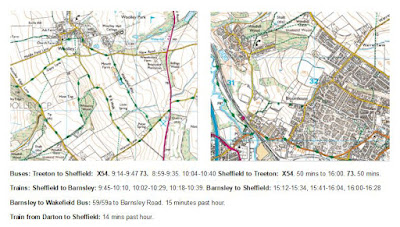 |
| Barnsley Town Hall |
On my day out to Blyth, having spent 2½ hours to get there using public transport, it was disappointing not to have a good look at the interior of the Priory Church of St. Mary and St. Martin Blyth, due to a wedding, but the unexpected opening of St. Nicholas’ church in Bawtry, for another wedding, made up for this.
To get to see a mediaeval church in a remote rural location, I had by now become very used to undertaking three separate journeys by public transport each way but, when opening times for coffee mornings etc. are not publicised on the internet, I have found that it can be extremely difficult to get a response to a request for a keyholder to open the church – a problem I again encountered on my next day out a few days later, when I visited Woolley in West Yorkshire.
Looking in my copy of Medieval Churches of West Yorkshire by Peter Ryder, I had discovered that it was possible to get to a few churches from both Barnsley and Wakefield, including St. Peter’s church in Woolley. Using the West Yorkshire Metro bus map and Google Map, I noted that the No. 97 bus directly serves Woolley, but it is infrequent and it would be better to use the No. 59 and alight at the Barnsley Road stop, which is only a 15 minutes walk from Woolley.
Having established the best way to get to Woolley, for my return journey I decided that I would plan a walk using public footpaths that would take me to Darton, which has regular buses to Barnsley and a train station that I used before when visiting All Saints church.
With my route for my walk planned, an online search seemed to indicate that the church would be open but, getting no response from the vicar to confirm this, I decided to make the journey anyway – especially since a British Listed Buildings Photo Challenge indicated that there were 35 buildings in the immediate area, although realistically I would probably only get access to 23 of these.
As often happens on my day trips where I have had to take a train to Barnsley, Doncaster and Wakefield before catching a bus to my final destination, the timing of the hourly No. 59 bus necessitated a wait of 35-45 minutes – depending on the train that I caught from Sheffield - and I planned to visit the Barnsley Civic, to see if there was a good exhibition in their art gallery space.
For several years, I had made a point of taking the train to Barnsley a few times a year to visit the Barnsley Civic and the Cooper Gallery, but on this occasion 5 minutes was enough time to appreciate “I’m Sorry” by the Grimsby based photographer, Annabel McCourt.
On previous visits to Barnsley, I had photographed most of the historic buildings in the Old Town Conservation Conservation Area and to pass the rest of the time before catching my bus, I had another good look at the balustrades surrounding Barnsley Town Hall, where the Portland stone has weathered to leave large fragments of oyster shells standing proud.
When I am in Barnsley, I often visit the Experience Barnsley Museum and Discovery Centre and have often stopped to look at and photograph these but, this time, I noticed that one fragment of shell has very distinct orange/brown banding.
I have never seen anything like this before in very many buildings, public monuments and Commonwealth War Graves Commission headstones made of Portland stone and I wonder if this is a rare example of original colouring being preserved. At this point, I just took a few quick snaps of the Coal Measures sandstone steps to the front of the town hall, which shows ripple marks and an unusual colour, before making my way back to Barnsley Interchange.










No comments:
Post a Comment